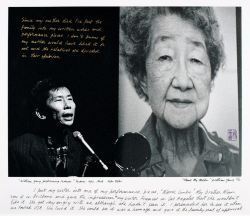Thinking Inside the Frame: Using Photographs to Tell Your Story
When I teach memoir writing, my students are mostly women. Whenever we have a male in the classroom, the whole dynamic changes. Often, they don’t want to get too touchy-feely or pour their souls out for a public audience. That’s fine. There are as many types of memoir, as there are memoir writers.

The exhibition.
In 2004 the Queensland Art Gallery purchased a collection of photographic images by the Australian society photographer, William Yang. These photos are a striking contrast to the gilt framed oils and quirky modern works throughout the gallery. They are a series of 30 black and white photographs, with one short paragraph hand-written under each photo: memoir in a new form… and even better, memoir in a strikingly simple and non-judgemental form. I took my class to view it, including our not so touchy-feely male (who was actually very warm and pleasant off paper.) Everyone walked out of the gallery inspired, considering how they could communicate conflicts and complex issues as easily.
William’s exhibition highlighted where his family had lived, their beliefs, their morals and their values. At no time was he ever judgemental about a family member or situation. He did release some skeletons from the family closet, but they were all his skeletons to set free. Out of respect, he waited until his close relatives were deceased before he did so. The picture he painted was realistic, but sensitive. I noticed that he honored his late mother in a simple and special way.

I was able to attend William’s lecture at the gallery. He is inspirational in many ways.
As the Art Gallery owns the collection, they allowed me to take the photo shown above; but due to copyright, I cannot reproduce the works in an easier to see form. You can view their page on William here. Below is some of the text which was with the photos.
“In 1979 I had a bad case of hepatitis and I came back to the house of my mother to recuperate. My mother liked having me at home under her control. But I felt the life I had chosen to lead was not in Brisbane, and when I was half better, I went back to Sydney.”
“In his day your father was a very dashing man. He played saxophone in a dance band, and he wore silk shirts. He wouldn’t let me iron them, he did them himself. I couldn’t iron them good enough” I stared at my mother in disbelief. “He wasn’t like you know him.” She said.”
“Frances was my father’s favorite. She was the apple of his eye. I was my mother’s favorite child. There was a friction between my mother and my sister. They were both strong women.”
You can see how simple, but strong the message is. There are no angst-ridden emotional dissections, or lengthy one-sided speeches that could cause family arguments to erupt, or lose your interest amid the details. William got straight to the point. He chose the most important aspects of his family life and how they had affected him. That is always a safe place to focus on controversial topics: how they affected you, rather than who committed what sin.
So when you are writing, whatever your gender, use your freedom to be creative and original. Memoir doesn’t have to be a series of dates or plain paragraphs in a book. You can communicate through art, scrapbooking, photos, story quilts, music etc: it’s up to you. Any form of memoir should reflect your personality and interests in life. It should be representative of the main character: you.
It is your story to tell. Tell it your way.

This work, created and Copyright Cate Russell-Cole 2014 is licensed under a Creative Commons Attribution-NonCommercial-NoDerivatives 4.0 International License.
Filed under: Memoir / Autobiography / Life Story Writing Tagged: autobiography, characterisation, creativity, ideas, inspiration, life story, memoir, Queensland Art Gallery, William Yang, writer, writing











